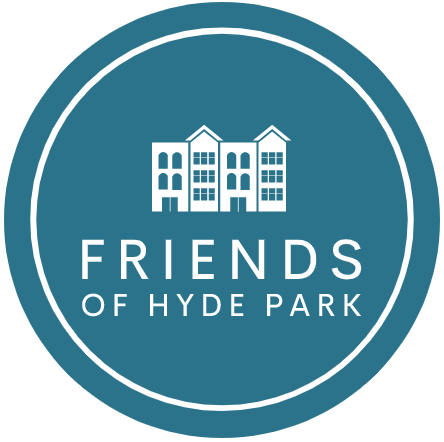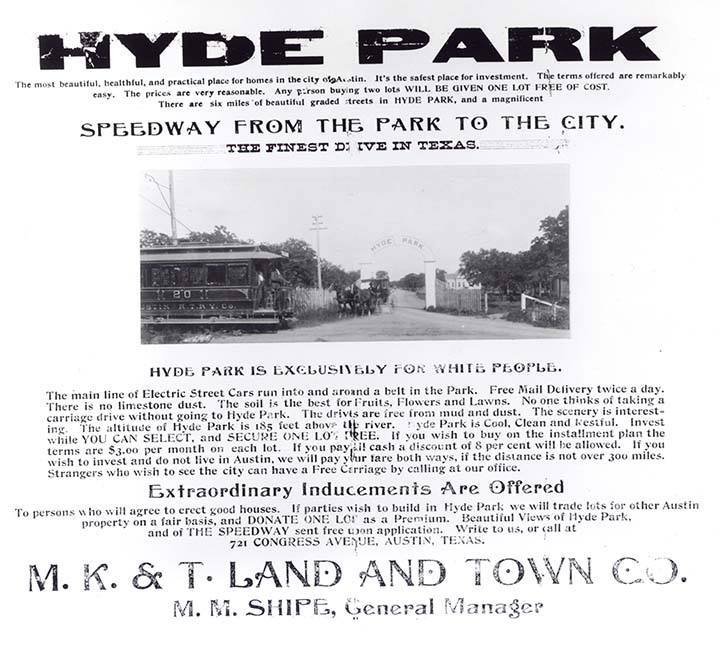Is Hyde Park “Exclusively for White People” Again? Austin City Council and CodeNEXT Staff Must Answer Questions
In CodeNEXT, Neighborhood Conservation Combining Districts (NCCDs) creating de-facto zoning barriers to class and race is not a zoning code. It’s a betrayal of Austin values. Friends of Hyde Park, the largest neighborhood association in Hyde Park, has unanswered questions and grave concerns on why the latest maps for CodeNEXT show the new land development code not applying to the area, resulting in Hyde Park no longer being considered a “core contributing” neighborhood to the recently passed Strategic Austin Housing Blueprint.
If the latest preliminary maps for CodeNEXT are approved by Austin City Council, the zoning for Hyde Park will be composed of the same NCCDs in the current code which have proven to inhibit affordability, class and racial diversity. NCCDs applied to Hyde Park (and other core neighborhoods in Central Austin) are a main reason much of current housing stock has become out-of-reach for nearly all Austinites, save upper middle-class and wealthy homeowners. For more information about how NCCDs impact Hyde Park and to view the previous Friends of Hyde Park voting results on a new land development code, click here.
Friends of Hyde Park is asking the City Council to implement what it approved through the Audit of Neighborhood Planning, “via a resolution, the City Council directed the CodeNEXT process to address this issue as part of the revision process. The Household Affordability Code Prescription agreed with and referenced the findings of the Impediments to Fair Housing Choice report. To address the impediments created by the opt-in/opt-out zoning practices allowed by the Neighborhood Plan Combining District sections of the Code, the prescription recommended that code provisions regarding the choosing of which infill options would be allowed in a planning areas be eliminated through the CodeNEXT process.”
Due to Austin’s housing crisis, CodeNEXT was born out of the desire of Austin City Council to correct these current and past systemic barriers to affordability on behalf of all Austinites. The Friends of Hyde Park has been a vocal supportive partner for the development of CodeNEXT and is supportive of the Strategic Austin Housing Plan to enable every Austinite to achieve housing security.
The Friends of Hyde Park board considers this result to benefit wealthy homeowners at the expense of our endangered middle and working-class as an affront to Austin values. We will not endorse a CodeNEXT land development code which codifies the 20th Century Jim Crow white-only deed restrictions in which Austin’s first suburb was founded. In the 21st Century, the future of Hyde Park zoning is a forward-thinking map which embraces missing-middle housing and needed density to grow a sustainable and diverse middle and working-class in Austin.
In order to pass CodeNEXT, Austin City Council must answer the following affordability, Fair Housing, legal and zoning questions regarding NCCDs:
- Are NCCDs a barrier to affordable housing?
- Do NCCDs decrease affordability for renters and homeowners?
- Do NCCDs violate Federal Fair Housing laws (through disparate impact or other violations)?
- “City Council adopted a resolution in December 2015 directing the city manager to analyze the potential for the CodeNEXT land development code revisions to affirmatively further fair housing, giving low and moderate income residents housing choices in high opportunity and gentrifying areas. The resolution also recommends that the code include as many affordable housing options as possible for Austinites at various income levels and household sizes. The analysis will inform the code and the code mapping process. The Code Prescription on Household Affordability contains further details.”
- Do/did NCCDs reduce the available housing stock in their respective neighborhoods?
- Do NCCDs encourage demolition of homes or multifamily structures?
- Do NCCDs reduce the population density of their respective neighborhoods?
- Do NCCDs reduce the property tax base in their respective neighborhoods?
- Do NCCDs increase development pressure on other neighborhoods?
- Do NCCDs increase displacement and gentrification in other neighborhoods?
- Do NCCDs violate or are they inconsistent with Imagine Austin?
- “Imagine Austin includes a growth concept map that identifies activity centers and corridors where growth is either anticipated or desired” like the Guadalupe activity corridor and that planning “ensures complete communities as the city grows.” Imagine Austin also calls for more housing “within 1/2 mile of retail and activity centers” and “units within 1/2 mile of transit and high capacity transit.” Imagine Austin also calls for new development and redevelopment to be “compact and connected” and a “process of creating a more efficient, predictable, and understandable Land Development Code.”
- Does keeping NCCDs align with stated goals of CodeNext and Imagine Austin?
- Do NCCDs help lay “out a vision for how the city can grow in a compact and connected way?”
- What impact do NCCDs have along Imagine Austin activity corridors and major roads regarding housing and businesses?
- Do NCCDs discourage creating walkable neighborhoods with walkable restaurants and businesses?
- Do NCCDs constitute an opt-in and opt-out process?
- According to the Audit of Neighborhood Planning, “via a resolution, the City Council directed the CodeNEXT process to address this issue as part of the revision process. The Household Affordability Code Prescription agreed with and referenced the findings of the Impediments to Fair Housing Choice report. To address the impediments created by the optin/opt-out zoning practices allowed by the Neighborhood Plan Combining District sections of the Code, the prescription recommended that code provisions regarding the choosing of which infill options would be allowed in a planning areas be eliminated through the CodeNEXT process.”
- Do these findings apply to NCCDs from the Audit of Neighborhood Planning:
- States that some of Austin’s previous neighborhood planning efforts “are not consistent with some elements of Imagine Austin,” and that “fair housing choice has not been specifically considered in most neighborhood planning efforts.” “The Analysis of Impediments to Fair Housing Choice report, completed for the City in 2015 and submitted to the federal government, identifies several barriers to housing choice related to neighborhood planning and its associated zoning. The report recommends that the City work through the CodeNEXT process to modify land use and regulatory barriers.”
- “Current land use policies and practices that do not incorporate fair housing concepts, if unaddressed, could create a risk of litigation against the City or a risk of losing federal grants.”
- “The Code Diagnosis report completed for the City as a part of the CodeNEXT process identified elements of the Code as being complex, causing delays directly connected to affordability. The diagnosis notes that the lack of transparency around neighborhoods opting in or out of some regulations in neighborhood plans contributes to this complexity.”
- The audit states that “a 2006 audit of the City of Austin’s long-term planning efforts found that neighborhood plans were neither consistent nor guided by a unified vision for the City.” These types of plans have not been “updated to reflect Imagine Austin,” may not reflect the “Imagine Austin comprehensive plan regarding the inclusion of goals,” and as a result “may not reflect the present-day needs and vision that stakeholders have for their neighborhoods or their city.”
- Has city legal conducted a legal review of NCCDs? If so, what were their findings?
- Are NCCDs consistent with the Texas Local Government Code and the Austin City Charter?
- The Texas local government code states, “a municipality may define, in its charter or by ordinance, the relationship between a comprehensive plan and development regulations and may provide standards for determining the consistency required between a plan and development regulations.” The Austin City Charter states that “all city regulatory actions relating to land use, subdivision and development approval shall be consistent with the comprehensive plan.”
- What reasons were provided for the creation of NCCDs by city council, city boards, and commissions?
- Was the creation of each NCCD transparent and included all stakeholders in the process?
- Was proper notice provided when creating NCCDs to homeowners that were downzoned and neighborhood residents for the rezoning to an NCCD? Was any part of the process inconsistent with what was legally required to create an NCCD?
- How many people were involved in the creation of each NCCD?
- Have NCCDs altered the neighborhoods from their original character before the NCCDs?
- Did NCCDs downzone portions of the neighborhoods that had always been allowed housing (examples: Hyde Park NCCD downzoned many properties along Speedway and Duval)? What impact did this have on housing, affordability, and transit?
- Do NCCDs encourage or discourage any housing choices?
- Do NCCDs ban any housing choices (especially housing that has historically been allowed in those neighborhoods)?
- Do NCCDs create non-conforming uses in their neighborhoods?
- Do NCCDs reflect the present-day needs and vision that stakeholders have for their neighborhoods or their city?
- Do NCCDs negatively impact transit options in their respective neighborhoods?
Board of Directors of Friends of Hyde Park
Pete Gilcrease
Teresa Griffin
Tommy Ates
Matt Desloge
Ricky Hennessy
Adam Luikart
Robert Prentiss

